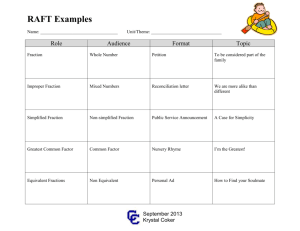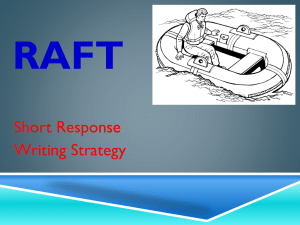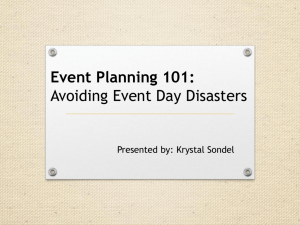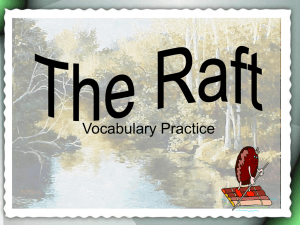RAFTs
advertisement
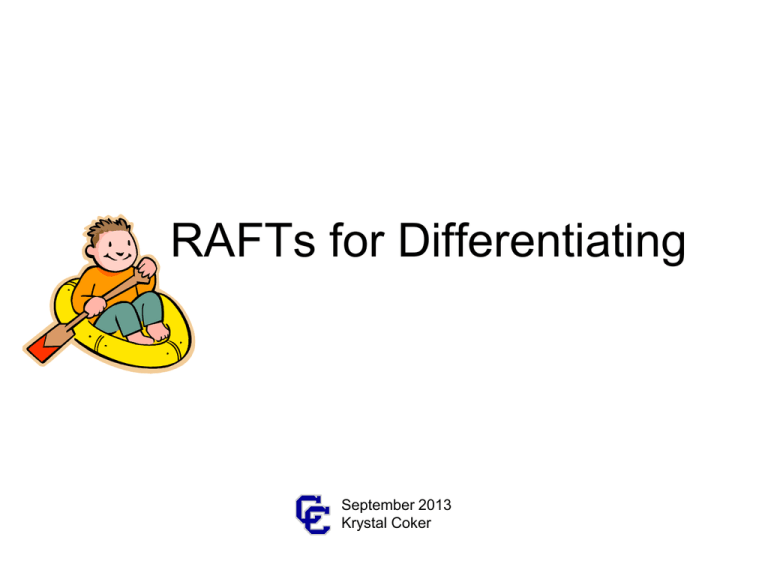
RAFTs for Differentiating September 2013 Krystal Coker A RAFT is… • …an engaging, high level strategy that encourages writing across the curriculum. • …a way to encourage students to… – …assume a role – …consider their audience – …examine a topic from a relative perspective – …write in a particular format September 2013 Krystal Coker RAFT acronym • Role of the Writer - Who are you as the writer? Are you Sir John A. Macdonald? A warrior? A homeless person? An auto mechanic? The endangered snail darter? • Audience - To whom are you writing? Is your audience the Canadian people? A friend? Your teacher? Readers of a newspaper? A local bank? • Format - What form will the writing take? Is it a letter? A classified ad? A speech? A poem? • Topic + strong Verb - What's the subject or the point of this piece? Is it to persuade a goddess to spare your life? To plead for a re-test? To call for stricter regulations on logging? September 2013 Krystal Coker RAFTs can… • Be differentiated in a variety of ways: readiness level, learning profile, and/or student interest • Be created by students • Be used as introductory hooks into a unit of study September 2013 Krystal Coker Possible RAFT Formats to Differentiate by Learning Modality Written Visual Oral Kinesthetic Diary entry Bulleted list Obituary Invitation Game rules Recipe Movie critic FAQs Editorial Gossip column Cartoon/Comic Crossword puzzle Map Graphic organizer Print ad Photograph Fashion design Song Monologue Radiocast Museum guide Commercial Interview Puppet show Political speech Story teller Model Cheer Mime Demonstration Sales pitch with demos Sew, cook, build Wax museum Game September 2013 Krystal Coker Differentiating a RAFT by Readiness (Teacher assigns RAFT or choices of RAFTs based on students’ reading, writing or performance levels) •Roles/Audience – Well-known people or charters to lesser known – Basic essential items (vocabulary, inventions, elements, etc.) to more esoteric items – Easier to understand point-of-view to more intangible perspective •Formats (while offering choices to students) – Shorter to longer (in prep, process or presentation) – More familiar to more unfamiliar formats – Single step to multiple steps September 2013 Krystal Coker Differentiating a RAFT by Readiness (continued) • Topics – Easier to interpret to more sophisticated – Concrete & literal to more abstract response – More structured to more open-ended – Small leap in insight & application to larger leap September 2013 Krystal Coker Analyzing a RAFT Lesson • What are the learning goals for this lesson and are they built into every choice? • How is this RAFT being differentiated? – Does it appeal to different learning styles? – Is there a range of difficulty in the: • Roles? • Formats? • Readiness levels? – Do the roles, formats or topics appeal to a variety of interests? September 2013 Krystal Coker RAFT Planning • Know (facts, vocab) – think about the know when planning the role or audience • Understand (statement) – think about the understand when writing the topics • Do (verb) – this might be the guide for the format September 2013 Krystal Coker Ways to use RAFTs • • • • • • • Assess prior knowledge before a unit Centers/Stations Exit Ticket Warm Up/Bell Ringer Formative assessment Alternative to a traditional assignment And the list goes on… September 2013 Krystal Coker RAFTs and Word Walls You have these lovely word walls…now what? Integrate word walls into your RAFTs! This will provide scaffolding within the differentiation by giving the students a word bank to use when they are writing. …or require students to use a certain number of words from the word wall into their RAFT assignment. September 2013 Krystal Coker
